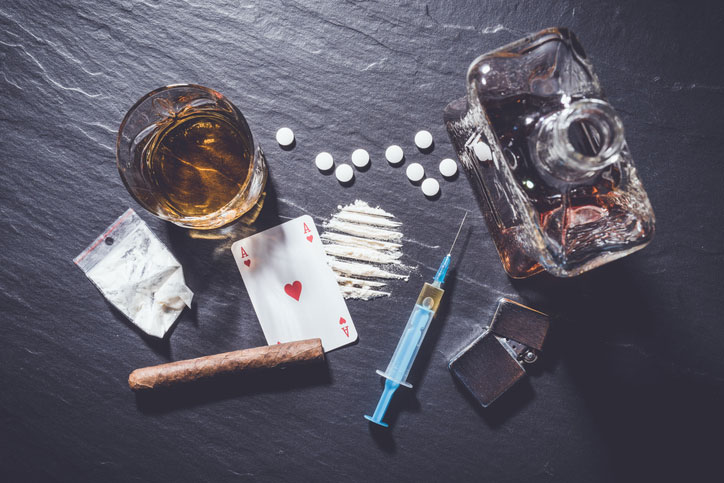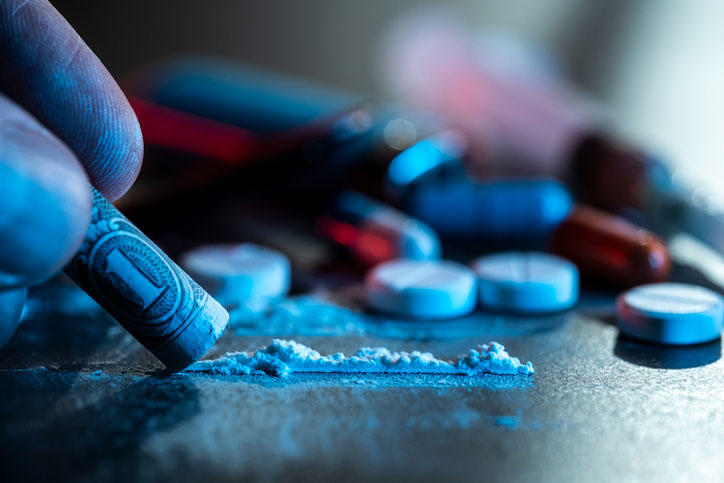Written by Dr. Emily R. Thornton, PhD, LCADC , Last Updated: November 4, 2025
Polysubstance abuse involves using multiple drugs simultaneously or sequentially, creating heightened risks of overdose and adverse reactions. Counselors gain training through formal SUD degree programs, continuing education courses offering CEUs, and supervised clinical practice with experienced mentors who understand regional trends in drug combinations.
Table of Contents
Every substance use disorder counselor eventually faces this sobering reality: the patient sitting across from you isn’t just battling heroin or just struggling with alcohol. They’re caught in a web of multiple substances, each amplifying the danger of the others. According to the National Institute on Drug Abuse, polysubstance use contributes to nearly 50% of overdose deaths in the United States. Yet many counseling programs barely address how to treat it.
In the classroom or in the news, addiction is often treated as an issue with distinctive roots and boundaries:
- It’s the opioid epidemic, a flood of heroin and synthetic opioids washing through America’s streets.
- It’s marijuana and THC, available legally in many states but often used illegally or in forms like edibles or vapes that are attractive to teens and children.
- It’s methamphetamines, cooked up in trailers and destroying rural communities.
- It’s alcoholism, silently killing thousands each year through liver disease and car accidents.
Every once in a while, you’ll see someone acknowledge that the addiction problem is all of the above. But outside the ranks of professional substance use disorder counselors or psychology professionals, you don’t often hear about the actual reality out on the streets: it’s usually all of the above, even in a single patient.
This is polysubstance abuse. It’s the most dangerous factor substance use disorder patients face in the United States today, and it’s a condition you’ll have to learn to treat if you want to help them.
Understanding the Polysubstance Crisis

Polysubstance abuse isn’t exactly a new phenomenon. Anyone you know who smokes and drinks to excess simultaneously is engaging in the practice. The classic speedball, mixing amphetamines with opioids to sustain euphoria while reducing anxiety and nervousness, has been around since at least the early 1980s and probably before.
It also has a long history of being exceptionally dangerous. Speedball overdoses killed Chris Farley, DJ Rashad, and River Phoenix. The Centers for Disease Control and Prevention reports that polysubstance use now accounts for roughly 47% of all overdose deaths, with the most lethal combinations involving opioids mixed with stimulants or benzodiazepines.
Some users have even attempted to use polysubstance doses in an attempt to self-treat addiction, similar to the way that methadone is used to medically treat opioid addiction.
Polysubstance abuse can also occur with prescription medications, particularly when used contrary to medical direction. Blends of adderall and xanax are often done to achieve an effect similar to combining Coke and heroin.
The inadvertent mixing of various drugs, as nicotine and alcohol, can be dangerous as well. Still, the most significant threats today are intentional efforts like mixing uppers and downers to try to tune a high. And with newer and more powerful drugs on both sides of that spectrum, that danger is greater than ever.
Why Polysubstance Abuse Is So Dangerous
The risks in severe polysubstance abuse are twofold:
- Substance users may be unaware of significant side effects or toxicity produced by drugs in combination that neither would have alone, and synergies can produce more potent effects at a given dosage.
- The effects of one drug may mask the physiological warning signs of overdose by the other.
These are both reasons why substance abuse counselors must understand the latest trends in polysubstance use and abuse in general, and in their area specifically.
Polysubstance abuse tends to fall into certain specific patterns, such as alcohol and cocaine, cocaine and opioids, or opioids and benzodiazepines. Each has their own key risk factors.
In general, studies consistently find that polysubstance abusers are at higher risk for:
- Overdose death, particularly from respiratory depression, occurs when opioids are combined with sedatives.
- Developing long-term physical health problems, including cardiovascular damage and liver disease.
- Experiencing declines in mental health, with higher rates of depression and anxiety disorders.
The combination of how common this is with the elevated danger shows just how important it is to master treating this condition for even new addiction counselors. Research from the Substance Abuse and Mental Health Services Administration indicates that approximately 30% to 40% of individuals seeking treatment for substance use disorders report using multiple substances.
Getting Formal Education in Polysubstance Treatment
A Formal College Education in Substance Use Disorders Is the Best Grounding
Your understanding of polysubstance abuse will come from your formal education in addiction counseling. The ground floor for understanding these complex chemical, physiological, and psychological interactions is a firm understanding of each of the individual drugs going into the mix.
There aren’t many courses in most SUD degree programs that explicitly address polysubstance use. You may run across it in diagnostic and assessment manuals, although polysubstance use disorder has been dropped from the DSM-5 as a formal and separate diagnosis. The DSM-5-TR, updated in 2022, now categorizes these cases under the specific substance use disorders present.
Your professors have definitely encountered polysubstance cases in practice and may discuss them in class even if they’re not on the syllabus. Don’t hesitate to ask questions about specific drug combinations you’re hearing about in the news or in your supervised practice hours.
Continuing Education Opens Up Specialized Training
Things open up when you get to continuing education courses. Researchers who have done a deep dive into polysubstance abuse have been good about turning their papers and projects into courses available both online and in person. Most offer CEUs that will go toward maintaining your license or certifications.
Even NAADAC has gotten in on the game, with a webinar specific to the increase in polysubstance abuse involving opioids.
Street-Wise Teachers and Mentors May Be Your Best Resource
The ultimate instruction comes through experience. The unique combinations of substances most common in your region will constantly evolve. What you pick up in school will offer an introduction, but you’ll have to keep learning and improving your understanding to keep up with the changes.
This is where your supervised practice will be critical. Mentorship from someone who is experienced in practicing both in your area and with the specific combinations of drugs in use will build out your own knowledge as you pursue active cases. Your supervisor can help you identify regional patterns, understand local drug supplies, and develop assessment skills specific to polysubstance presentations.
Exploring Treatment Options for Polysubstance Abuse

Certain types of therapy may be more useful than others in approaching polysubstance addictions. For example, traditional methadone maintenance treatment for opioid addiction can have a limited effect when the opioid is only part of the addiction equation. Studies have shown that MMT can be less effective in patients who are also using other types of both legal and illegal substances.
On the other hand, the benefits of treating polysubstance abuse as a package deal are well proven. Studies have found that something as simple as dealing with tobacco dependence as part of treatment is associated with a 25 percent increase in long-term abstinence from alcohol and other substances.
There are also plenty of fairly generalized treatment methodologies that should be just as effective in polysubstance abuse treatment, since they aren’t substance-specific in the first place. Motivational Enhancement Therapy (MET), Cognitive Behavioral Therapy (CBT), and relapse prevention techniques focus primarily on internal drivers and can cover multiple types of addictions simultaneously.
Integrated Treatment Approaches Work Best
The key to successful polysubstance abuse treatment is addressing all substances concurrently rather than in isolation. Integrated treatment plans should:
- Assess the full spectrum of substances being used, including legal drugs like alcohol and nicotine.
- Identify the primary substance of concern while addressing secondary dependencies.
- Consider medication-assisted treatment options for multiple substance dependencies.
- Monitor for cross-addiction or substitution behaviors during recovery.
When Polysubstance Use Becomes Treatment
There’s one other reason new substance abuse counselors need to gett up to speed on polysubstance use: it just could be part of your next successful treatment plan.
Just as the street finds its own uses for various substances designed for treating other conditions, it turns out that a specific subset of addiction patients have experimented with the use of hallucinogenic drugs to kick other substance use disorders. Ibogaine, in particular, a hallucinogen used in shamanic rituals in central Africa, has a reputation for helping people kick other habits.
They describe intensive trips that feel like undergoing years of therapy in a matter of hours, and a reduction in cravings afterward. But there is considerable debate in the field right now about the use of hallucinogens in the treatment of addiction.
As with most hallucinogens, individual experiences vary. At worst, ibogaine itself can cause seizures or heart attacks.
Controlled studies of such substances are rare, since they are often tightly controlled Schedule I drugs themselves. Animal research has proven encouraging, and the underground rumor mill offers plenty of success stories from human users.
But scientists have begun to synthesize variants that may deliver recovery without hallucinations. Findings published by chemists at the University of California, San Francisco, in 2023 describe two potential new drugs modeled on ibogaine’s molecular structure.
While these are years, if not decades, from being actually trialed chemically, they may offer a drug that can be taken in tandem with others as a kind of cure. Like methadone for opioids, but with lower maintenance requirements and more applications, this kind of polysubstance use could completely revolutionize addiction therapy. You’ll want to be well-informed about all the pluses and minuses as you launch your career in addiction treatment.
Frequently Asked Questions
What is polysubstance abuse?
Polysubstance abuse is the use of multiple drugs simultaneously or sequentially within a short time period. This can include combinations of illegal drugs, prescription medications, alcohol, and other substances. The practice significantly increases health risks due to unpredictable drug interactions and synergistic effects.
How everyday is polysubstance use among addiction patients?
According to SAMHSA data, approximately 30% to 40% of individuals seeking substance use disorder treatment report using multiple substances. The National Institute on Drug Abuse reports that polysubstance use contributes to nearly 50% of overdose deaths in the United States.
What training do I need to treat polysubstance abuse as a counselor?
You’ll need a formal education through an accredited SUD degree program, completion of supervised clinical hours working with polysubstance cases, and continuing education courses focused on complex addiction presentations. Many counselors also pursue specialized training in assessment and integrated treatment approaches.
Are there specific certifications for polysubstance treatment?
While there isn’t a standalone polysubstance abuse certification, advanced counselor credentials like CADC, LCADC, or LADC typically include training in treating complex cases involving multiple substances. Continuing education courses in polysubstance treatment can help you specialize in this area.
What are the most dangerous drug combinations?
The most lethal combinations typically involve opioids mixed with benzodiazepines or stimulants. Both combinations can lead to respiratory depression, cardiac arrest, or unpredictable overdose symptoms. Alcohol combined with any central nervous system depressant also poses extreme danger.
How does polysubstance abuse affect treatment outcomes?
Polysubstance use often complicates treatment and may reduce success rates when substances are addressed individually. Research shows that integrated treatment approaches that address all substances simultaneously achieve better outcomes, with studies showing up to 25% improvement in long-term abstinence rates.
Key Takeaways
- Polysubstance abuse affects 30-40% of SUD patients and contributes to nearly half of all overdose deaths in the U.S.
- The most dangerous combinations involve opioids mixed with benzodiazepines or stimulants, which can mask overdose symptoms.
- Formal SUD degree programs provide the foundation, but specialized knowledge comes from continuing education and supervised practice.
- Integrated treatment approaches that address all substances simultaneously show 25% better long-term abstinence rates.
- Regional mentorship is critical since polysubstance patterns vary significantly by location and change constantly.
- Emerging therapies, including synthesized psychedelic compounds, may revolutionize polysubstance treatment in the coming years.
Ready to Make a Difference in Polysubstance Abuse Treatment?
Discover degree programs that prepare you to handle complex addiction cases and build the skills you need for this critical specialty.






